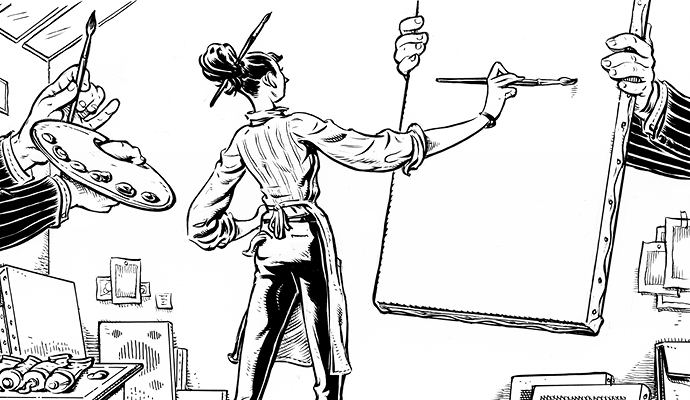There is such a thing as too much freedom
The challenge for businesses is finding a balance in the hybrid working world.
It might seem a bit weird to be talking about the consequences of too much freedom at a time when so many of us have too little of it. What does freedom even mean when you’re hemmed in by work, family obligations, and, of course, a global pandemic?
But the pandemic has forced a reset for so much of how we do work, including where work is done — whether we’re in an office or at our kitchen tables — and what “work hours” really means. Questions about freedom and autonomy are central to figuring out how work will change through this experience and beyond it. With the hybrid office set to become the norm, now — and not later — is the time to think about what meaningful independence and productive autonomy look like in the context of work.
No one likes to feel controlled or stripped of agency, but there is evidence that we need boundaries to keep focused. The key is finding that sweet spot somewhere between too little freedom and too much. It’s what Ben Gateley, CEO and founder of CharlieHR, a human resources software company, calls structured flexibility: the confines that we as people perform the best within. “I actually don’t think we perform our best with complete openness and flexibility,” he told me.
No one likes to feel controlled or stripped of agency, but there is evidence that we need boundaries to keep focused. The key is finding that sweet spot somewhere between too little freedom and too much.
Gateley would know. When CharlieHR launched in 2015, the fledgling company tried an experiment: Employees could take as much paid holiday time as they wanted, whenever they wanted it. “We just thought it made sense to give people as much autonomy as possible,” said Gateley.
Three years later, the company rescinded the program. “As we matured, we began to see some of the challenges in that policy,” said Gateley. Without boundaries, there was no clarity: How much holiday time was too much? How much was too little? Was it fair that some people took 35 days, while others took 25? And as CharlieHR grew, the company saw a distinct difference between the paid time off taken by people with families and by single people, or by people at different stages of their career (read: less income, fewer options for holiday). “It generated a good amount of anxiety among the team,” Gateley said. By and large, people were grateful when the policy was axed in favor of a generous but not open-ended holiday allowance.
Freedom to function
On a very basic level, we need freedom to function. Research has demonstrated that autonomy — not only preserving a sense of control over our actions but also seeing an alignment between our core values and our actions — is important to well-being in general; and much of the research on autonomy in the workplace further underscores just how important control is to employees’ sense of effectiveness and value in a company.
Being told what to do, even if it aligns with what we believe or say we believe, can make us angry. In 1966, psychologist Jack Brehm gave this phenomenon (which is well-known to parents everywhere) a name: psychological reactance. Simply put, his theory was that when we perceive a threat to our freedom, we react negatively (cue tantrum). There is, of course, personal variation — the more you value your freedom, the greater your negative reaction — but the principle applies for many people. Limiting our choices makes us anxious, frustrated, and sometimes, motivated to do exactly the opposite of what we’re being told to do.
It would stand to reason, then, that by maximizing choices, we maximize an individual’s sense of agency and freedom, and therefore, their well-being. As it turns out, that’s not quite the case. Though limiting freedom of choice makes life unpleasant, there’s a competing psychological force at work: the paradox of choice. The phrase was coined by psychologist Barry Schwartz back in 2004 to describe the negative effects of having too many options — for example, being confronted by too many different kinds of jam on a supermarket shelf.
This is an actual example from a famous 2000 study that Schwartz cited, which found that people were more likely to purchase fancy or new types of jam or chocolate when presented with just six choices than when they were offered upward of 24. Too much choice can leave us feeling anxious and unable to make an effective decision, and, ironically, less likely to try something new.
Schwartz was describing the excess of choice consumers face, but it’s a principle that he later applied to broader concepts, suggesting “that the same processes that seem to threaten well-being when people are completely free to choose what to buy also threaten well-being when people are completely free to choose how or who to be.”
And that principle can include employees. Right now, we’re living through a huge, uncontrolled experiment in what happens when you remove the usual boundaries that surround work. And the results are mixed. Back in April, Bloomberg reported that pandemic-induced working from home had “obliterated” work–life balance, and that people were working longer than before and on weekends. Later surveys showed that people felt more productive and their employers agreed, but that productivity gains can also come at the cost of health, both mental and physical: Nearly one in four people surveyed in June 2020 by the Working@home project, supported by the University of Stirling, in Scotland, reported being in poor or very poor general health, and one-third said household conflicts had increased. Most evidence from surveys and studies indicates that people need to reinforce boundaries between work and home life, now that work is home. And they can’t do that alone.
It’s worth noting that what didn’t work for CharlieHR has worked for other companies — most notably, streaming behemoth Netflix, which began offering unlimited holidays for salaried employees in 2019. In his book No Rules Rules, Netflix CEO Reed Hastings described the combination of “freedom and responsibility” that underscores the company’s policy decisions; so far, it’s worked out.
“When you give people freedom, most of them, not all of them will take on the responsibility,” said Chuck Blakeman, entrepreneur, author, and founder of business consultancy Crankset Group. When he offered his employees unlimited holidays, the biggest problem was that people just didn’t take them. It required a cultural shift within the company to help people see that holidays were encouraged, and that taking a vacation wouldn’t affect their position in the company or with their peers. “Nobody is telling them what to do anymore. They have to figure it out themselves. They have to learn the discipline to walk away,” he told me.
But this tale of two holiday policies underscores the point that there is no one-size-fits-all approach; companies are best served by periodically and critically reassessing their policies. Choice and a sense of agency are necessary parts of a functioning work culture; no one should ever feel oppressed or disenfranchised. But a little freedom can go a long way — and getting it right means making sure that it’s causing more good than harm.






